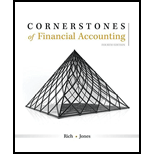
(a)
Introduction:
Investment in debt security (available for sale securities and trading securities) as well as equity securities is recorded using Fair Value Method.
To record:
Answer to Problem 27E
Journal Entries
| Date | S. No. | Particulars | Debit ($) | Credit ($) |
| Date Not given |
a. | Investment − Trading Securities Dr. Cash (Being Trading Securities of ‘B’ stock purchased.) |
12,800 | 12,800 |
| Date Not given |
b. | Cash Dr. Dividend Income (Being dividend received on trading securities.) |
320 | 320 |
| Date Not given |
c. | Cash Dr. Loss on Sale of Investments Investments − Trading Securities (Being Trading Securities sold.) |
2,440 120 |
2,560 |
| Date Not given |
d. | Investment − Trading Securities Dr. Cash (Being Trading Securities of ‘N’ stock purchased.) |
20,900 | 20,900 |
| Date Not given |
e. | Cash Dr. Dividend Income (Being dividend received on trading securities.) |
380 | 380 |
Explanation of Solution
a. No. of shares = 200
Acquisition Cost = $12,800
Acquisition Cost per share =
b. No. of shares = 200
Dividend per share = $1.60
Total Dividend received =
c. No. of shares sold = 40
Selling Price per share = $61
Selling Price for 40 shares =
Acquisition Cost per share = $64
Acquisition Cost of 40 shares =
Loss on Sale of Investment = Acquisition Cost of 40 shares - Selling Price for 40 shares
Loss on Sale of Investment = $2,560 - $2,440 = $120
d. No. of shares = 380
Acquisition Cost = $20,900
Acquisition Cost per share =
e. No. of shares = 380
Dividend per share = $1
Total Dividend received =
(b)
Introduction:
Investment in debt security (available for sale securities and trading securities) as well as equity securities is recorded using Fair Value Method.
To calculate:
Fair Value of the portfolio.
Answer to Problem 27E
The Fair Value of portfolio on December 31 would be $32,020.
Explanation of Solution
| Company | No. of Shares | Market Value Per Share | Fair Value (Market Value) |
| B | 160 | $60 | |
| N | 380 | $59 | |
| Total | 540 | $32,020 |
200 shares of ‘B’ stock were purchased, although (later) 40 were sold.
Currently, the company holds 160 shares (i.e. 200 shares − 40 shares).
(c)
Introduction:
Investment in debt security (available for sale securities and trading securities) as well as equity securities is recorded using Fair Value Method.
To prepare:
Answer to Problem 27E
Adjusting entry to record ‘Available for Sale Securities’ at market value
| Date | Particulars | Debit ($) | Credit ($) |
| Dec 31, 2020 | Allowance to Adjust Available for Sale Securities to Market Dr. Unrealized Gain on Trading Securities |
880 | 880 |
Explanation of Solution
| Securities | Acquisition Cost (1) | Fair Value at Dec 31, 2020 (2) | Difference [(2) − (1)] |
| B | $10,240 | $9,600 | (640) |
| N | $20,900 | $22,420 | $1,520 |
| Total | $31,140 | $32,020 | 880 |
Net Investments in ‘B’ is 160 shares.
Acquisition Cost per share = $64
Acquisition Cost of 160 shares =
(d)
Introduction:
Investment in debt security (available for sale securities and trading securities) as well as equity securities is recorded using Fair Value Method.
To show:
Effect on Income Statement due to the adjusting entry.
Answer to Problem 27E
‘Unrealized Gain on Trading Securities’ of $880 will increase the net income at the end of the year.
Explanation of Solution
| Securities | Acquisition Cost (1) | Fair Value at Dec 31, 2020 (2) | Difference [(2) − (1)] |
| B | $10,240 | $9,600 | (640) |
| N | $20,900 | $22,420 | $1,520 |
| Total | $31,140 | $32,020 | 880 |
Total Dividend Income = $320 + $380 = $700
- The change in total value of trading securities and available for sale securities is calculated.
- If the Fair Value is more than Acquisition Cost then the increase in value is shown as ‘Unrealized Gain on Trading Securities’ or ‘Unrealized Gain on Available for Sale Securities’.
- If the Fair Value is less than Acquisition Cost then the decrease in value is shown as ‘Unrealized Loss on Trading Securities’ or ‘Unrealized Loss on available for sale securities’.
- ‘Unrealized Gain’ on both is added in book value of investment on the
balance sheet so that it results in the fair market value of the investment whereas ‘Unrealized Loss’ is deducted from the book value of investment. - ‘Unrealized Gain on Trading Securities’ or ‘Unrealized Loss on Trading Securities’ is shown on the Income Statement under the head ‘Other Income’ or ‘Other Loss’, respectively.
- ‘Unrealized Gain on Available for Sale Securities’ or ‘Unrealized Loss on Available for Sale Securities’ is shown as part of ‘Accumulated Other Comprehensive Income’ in the
stockholders’ equity as separate head. It doesn’t affect the Income Statement, instead affects the stockholders’ equity.
PARTIAL INCOME STATEMENT
For year ended December 31.
| Particulars | $ |
| Other Loss:Loss on Sale of Investments Other Income:Unrealized Gain on Trading Securities Dividend Income |
120 880 700 |
(e)
Introduction:
Investment in debt security (available for sale securities and trading securities) as well as equity securities is recorded using Fair Value Method.
To show:
Securities on December 31 Balance Sheet.
Answer to Problem 27E
PARTIAL BALANCE SHEET
As at December 31
| ASSETS | Sub-total ($) | Total ($) |
| Current Assets:Trading Securities at cost (+) Allowance to Adjust Trading Securities to Market Trading Securities at market |
31,140 880 |
32,020 |
Explanation of Solution
| Securities | Acquisition Cost (1) | Fair Value at Dec 31, 2020 (2) | Difference [(2) − (1)] |
| B | $10,240 | $9,600 | (640) |
| N | $20,900 | $22,420 | $1,520 |
| Total | $31,140 | $32,020 | 880 |
- The change in total value of trading securities and available for sale securities is calculated.
- If the Fair Value is more than Acquisition Cost then the increase in value is shown as ‘Unrealized Gain on Trading Securities’ or ‘Unrealized Gain on Available for Sale Securities’.
- If the Fair Value is less than Acquisition Cost then the decrease in value is shown as ‘Unrealized Loss on Trading Securities’ or ‘Unrealized Loss on available for sale securities’.
- ‘Unrealized Gain’ on both is added in book value of investment on the balance sheet so that it results in the fair market value of the investment whereas ‘Unrealized Loss’ is deducted from the book value of investment.
- ‘Unrealized Gain on Trading Securities’ or ‘Unrealized Loss on Trading Securities’ is shown on the Income Statement under the head ‘Other Income’ or ‘Other Loss’, respectively.
- ‘Unrealized Gain on Available for Sale Securities’ or ‘Unrealized Loss on Available for Sale Securities’ is shown as part of ‘Accumulated Other Comprehensive Income’ in the stockholders’ equity as separate head. It doesn’t affect the Income Statement, instead affects the stockholders’ equity.
Want to see more full solutions like this?
Chapter A2 Solutions
Cornerstones of Financial Accounting
- How can I solve this financial accounting problem using the appropriate financial process?arrow_forwardCrystal Enterprises incurred manufacturing overhead costs of $275,000. Total overhead applied to jobs was $282,000. What was the amount of overapplied or underapplied overhead? HELParrow_forwardWhat is the break even sales amount?arrow_forward
 Accounting (Text Only)AccountingISBN:9781285743615Author:Carl Warren, James M. Reeve, Jonathan DuchacPublisher:Cengage Learning
Accounting (Text Only)AccountingISBN:9781285743615Author:Carl Warren, James M. Reeve, Jonathan DuchacPublisher:Cengage Learning Financial AccountingAccountingISBN:9781305088436Author:Carl Warren, Jim Reeve, Jonathan DuchacPublisher:Cengage Learning
Financial AccountingAccountingISBN:9781305088436Author:Carl Warren, Jim Reeve, Jonathan DuchacPublisher:Cengage Learning College Accounting, Chapters 1-27AccountingISBN:9781337794756Author:HEINTZ, James A.Publisher:Cengage Learning,
College Accounting, Chapters 1-27AccountingISBN:9781337794756Author:HEINTZ, James A.Publisher:Cengage Learning, Financial Accounting: The Impact on Decision Make...AccountingISBN:9781305654174Author:Gary A. Porter, Curtis L. NortonPublisher:Cengage Learning
Financial Accounting: The Impact on Decision Make...AccountingISBN:9781305654174Author:Gary A. Porter, Curtis L. NortonPublisher:Cengage Learning




